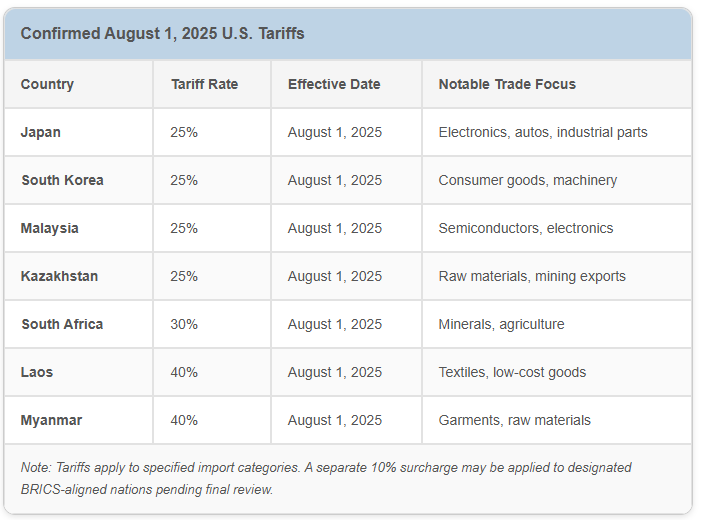
| 🚨Tariff Headlines You Should Know August 1st Tariff Deadline President Trump on Wednesday said he would be sending letters to over 150 countries as he plans a barrage of duties to take effect Aug. 1, including levies on pharmaceutical imports and semiconductors. The letters set new baseline tariff levels at 20% to 40% — except for a 50% levy on goods from Brazil. The tariffs on Brazil have raised the stakes for India. Bloomberg reported on a framework deal that could see US tariffs on goods from India drop below 20%. Last week, Trump announced a 35% tariff on Canadian goods and followed up with promises of 30% duties on Mexico and the EU. It is still unclear whether USMCA-exempt products will be subject to these potential 35% Canadian tariffs. The EU has been preparing an extensive list of counter-tariffs that would affect $84 billion of American products should talks fail. Earlier this week, Trump said his team has struck a trade deal with Indonesia that will see goods from the country face a 19% tariff, lowering the rate he had threatened in his letter. Two weeks ago, it was announced that Vietnam imports face a 20% tariff — lower than the 46% Trump threatened in April. With a higher 40% tariff “on any transshipping” — when goods shipped from Vietnam originate elsewhere, like China. As of August 1st a 25% tariff will be reinstated on imports from China, including electric vehicles, steel, and semiconductors. As of today, it is still unclear whether there will be any time exemptions, but it is expected that all entries will be subject to new tariffs on Aug 1, regardless of whether it was on the water prior to the announcement. 🔍What This Means for Your Supply Chain Cost Fluctuations: Prepare for potential spikes in customs duties and compliance fees. Short-term rate increases are possible as shippers rush to bring goods in before the August 1 deadline. Documentation Readiness: Expect enhanced customs scrutiny—ensure all commercial invoices and origin documentation are in order. Supply Chain Realignment: Companies importing materials from newly tariffed nations may accelerate sourcing shifts toward tariff-exempt countries. Port Volume Shifts: Certain U.S. ports may see decreased volume on affected trade lanes and increased volume from alternative routes. Political Uncertainty: Sudden changes in trade policy can create unpredictability for long-term contracting in container, Ro-Ro, and bulk cargo sectors. |


| Talk With Our Global Trade Experts, We’re here to Help! Have questions about how tariffs impact your cargo or costs? Contact us at Info@Richard-Murray.com or call 251-432-5549. Visit www.Richard-Murray.com to learn more about our network of service. Thank you for trusting Richard Murray & Co. as your global logistics partner. We’ll continue to keep you informed and prepared—no matter how trade winds shift. |


